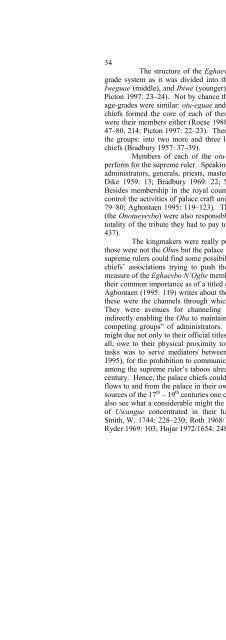Bondarenko Dmitri M. Homoarchy
Bondarenko Dmitri M. Homoarchy
Bondarenko Dmitri M. Homoarchy
You also want an ePaper? Increase the reach of your titles
YUMPU automatically turns print PDFs into web optimized ePapers that Google loves.
34<br />
The structure of the Eghaevbo N’Ogbe reproduced the Binis’ agegrade<br />
system as it was divided into three groups (otu-eguae): Iwebo (elder),<br />
Iweguae (middle), and Ibiwe (younger) (for detail see: Bradbury 1957: 37–38;<br />
Picton 1997: 23–24). Not by chance the names of the three groups and of the<br />
age-grades were similar: otu-eguae and otu respectively. To be correct, palace<br />
chiefs formed the core of each of these groups as some other administrators<br />
were their members either (Roese 1988: 55–61, 68; 1993; Eweka, E. B. 1992:<br />
47–80, 214; Picton 1997: 22–23). There also was internal gradation in each of<br />
the groups: into two more and three less highly ranked subgroups of palace<br />
chiefs (Bradbury 1957: 37–39).<br />
Members of each of the otu-eguae had a specific set of duties to<br />
perform for the supreme ruler. Speaking generally, the Eghaevbo N’Ogbe were<br />
administrators, generals, priests, masters of ceremonies (Egharevba 1956: 28;<br />
Dike 1959: 13; Bradbury 1969: 22; Nevadomsky and Inneh 1984: 48–50).<br />
Besides membership in the royal council, they had another common duty: to<br />
control the activities of palace craft unions (Eweka, E. B. 1992: 53–57, 69–77,<br />
79–80; Agbontaen 1995: 119–123). The Obas’ deputies in the annexed lands<br />
(the Onotueyevbo) were also responsible at them, first of all for regularity and<br />
totality of the tribute they had to pay to the Benin supreme ruler (Roese 1993:<br />
437).<br />
The kingmakers were really pushed to the background but eventually<br />
those were not the Obas but the palace chiefs who came to the fore. No doubt,<br />
supreme rulers could find some possibilities for maneuvering among the palace<br />
chiefs’ associations trying to push them against each other. However, the<br />
measure of the Eghaevbo N’Ogbe members’ corporativity was high enough and<br />
their common importance as of a titled chiefs category was great. In particular,<br />
Agbontaen (1995: 119) writes about the palace chiefs: “On the political plane,<br />
these were the channels through which palace functions were differentiated.<br />
They were avenues for channeling competitions among the groups, and<br />
indirectly enabling the Oba to maintain stability and political balance between<br />
competing groups” of administrators. The Eghaevbo N’Ogbe acquired their<br />
might due not only to their official titles and rights but also, maybe even first of<br />
all, owe to their physical proximity to the supreme ruler. One of their main<br />
tasks was to serve mediators between the Oba and the people (Agbontaen<br />
1995), for the prohibition to communicate with his subjects freely seems to be<br />
among the supreme ruler’s taboos already at least in the beginning of the 17 th<br />
century. Hence, the palace chiefs could rather easily “regulate” the information<br />
flows to and from the palace in their own interests. From the European written<br />
sources of the 17 th – 19 th centuries one can see that these chiefs really did it, and<br />
also see what a considerable might the Eghaevbo N’Ogbe under the leadership<br />
of Uwangue concentrated in their hands that time (Nyendael 1705: 435;<br />
Smith, W. 1744: 228–230; Roth 1968/1903: 92; Anonymous 1969/1652: 309;<br />
Ryder 1969: 103; Hнjar 1972/1654: 248–249; Dapper 1975/1668: 503; Dantzig







